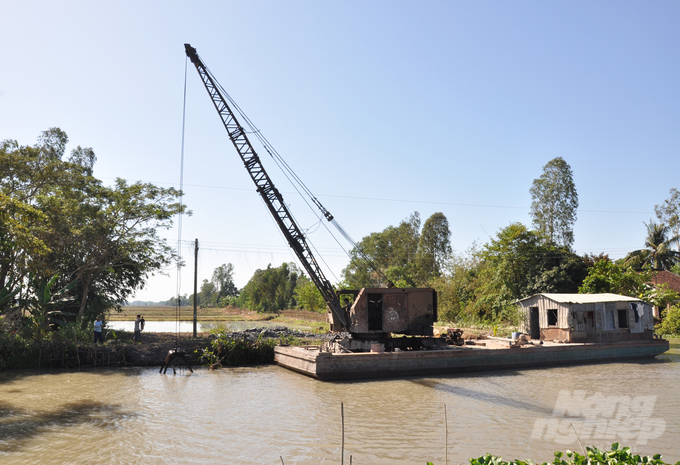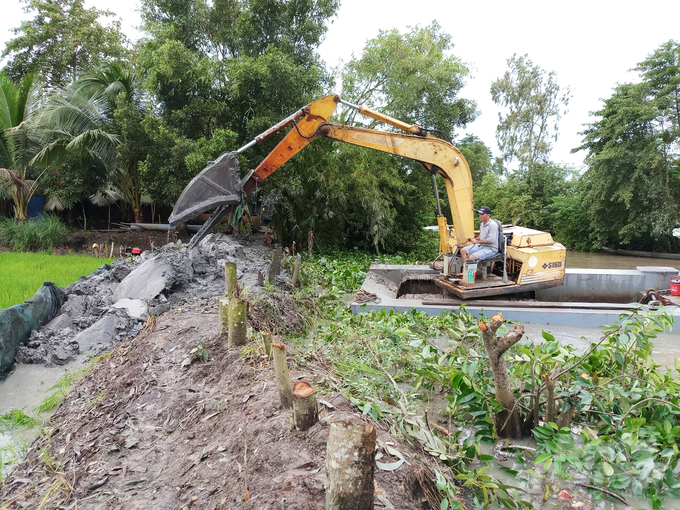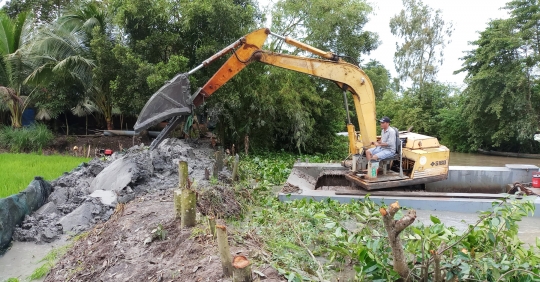
Dredging field channels in Thoi Lai District, Can Tho City. Picture: Minh Dam.
City. Can Tho hastens to set up irrigation systems on the field before the rainy season. Over the years, the irrigation system in the area has contributed to the city’s agricultural production successes. Can Tho grows three rice plants each year with a production of over 1.3 million tons. The production of fruit trees reached nearly 170,000 tons, aquaculture reached over 220,000 tons.
However, like many places in the Mekong Delta, Can Tho City has advantages with an intertwined system of rivers, canals and canals, but is disadvantaged due to natural sedimentation affected by flood season and tide. Therefore, irrigation work on the field needs to start early in the year so that it can be completed before the start of the flood season in September.
Mr. Nguyen Quy Ninh, Head of Can Tho Irrigation Sub-division, said: According to the plan, during the 2023 dry season, the site will dredge irrigation works totaling about 378,000m3 and expand and reinforce the embankment with a structure volume of about 22,000m3.
The total cost of implementation is over VND 10 billion from the budget and community contributions. So far, the implementation progress is over 50%. On-site irrigation projects are expected to be completed in August 2023. The construction of the dike to cover the A7 Canal in Thoi Hung Township of Co Do District is under construction until the end of the year. As for some secondary channels, they need to be dredged periodically every 5-7 years to create water sources and use medium-term investment capital. The city will make plans for the continuation of construction in order of priority.
Although the irrigation system was effective, ensuring water supply and drainage for rice-growing areas, orchards and aquaculture areas, Mr. Ninh said it needs major investment in the face of the challenge of climate change. Inconsistent, unpredictable weather changes.
The city of Can Tho is the center of the Mekong Delta region. However, with the rapid development of urban areas and industrial areas, the city now has more than 114,000 hectares of agricultural land, which accounts for almost 80% of the natural land area. These are more than 78,000 ha of rice cultivation area, 1,900 ha of annual crops, 30,800 ha of perennial crops and almost 2,800 ha of aquaculture areas… Agricultural production remains one of the pillars of the economy. Stable economic growth that accounts for nearly 6% of the city’s gross domestic product (GRDP).

Strengthen dikes, protect rice-growing areas. Picture: Minh Dam.
currently city. Can Tho is still engaged in large-field rice cultivation, each harvest covers more than 32,000 hectares, with more than 23,500 farmer households participating in the production cooperation. Meanwhile, the fruit-growing area in Phong Dien district has formed sub-regions with dikes to protect against flooding during the rainy season and high tide.
However, in order to expand large fields and develop safe specialty orchards, irrigation must continue to be fully supplemented. Mr. Tran Thai Nghiem, deputy director of the Ministry of Agriculture and Rural Development of Can Tho City, added: The city plans to build a rice cultivation area of 50,000 hectares in the three districts of Thoi Lai, Co Do and Vinh Thanh to participate in the development project. Sustainable one million hectares of high-quality rice cultivation combined with green growth in the Mekong Delta.
“On the basis of the main canal system, irrigation canals were essentially invested on site. The Ministry of Agriculture and Rural Development estimates the investment cost of about VND 200 billion to dredge the canal and provide water supply and drainage. Invest in the.” Levee system, add pumping stations for rice-growing sub-regions. In order to protect the dyke areas to protect the orchards that the town recently planted and which are now degraded, they need to be surveyed. The investments continue to be completed,” said Mr. Tran Thai Nghiem, Deputy Director of the Ministry of Agriculture and Rural Development of Can Tho City.

